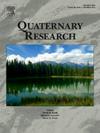New insights into the glacial and relative sea-level history of the western Fraser Lowland based on sediment cores from geotechnical drilling for the Evergreen Tunnel, British Columbia, Canada
IF 1.8
3区 地球科学
Q3 GEOGRAPHY, PHYSICAL
引用次数: 0
Abstract
Geotechnical drilling for a tunnel between Port Moody and Burnaby, BC, Canada, uncovered a buried fjord. Its sedimentary fill has a thickness of at least 130 m and extends more than 37 m below present mean sea level. Recovered sediments record cyclical growth and decay of successive Cordilleran ice sheets. The oldest sediments comprise 58 m of almost stoneless silt conformably overlying ice-proximal sediments and till, which in turn overlie bedrock. These sediments may predate Marine Isotope Stage (MIS) 4. Glacial sediments assigned to MIS 4 overlie this basal succession and, in turn, are overlain by MIS 3 interstadial sediments and sediments from two MIS 2 glacial advances. Indicators of relative sea-level elevations that bracket glacial deposits of MIS 4 and 2 indicate the cyclic existence of moat-like isostatic depressions in the front of expanding ice sheets. Compared with present sea level, these depressions were at least 160 m during the onsets of MIS 4 and MIS 2. Assuming a maximum eustatic drawdown of 120 m during MIS 2, isostatic depression may have exceeded 200 m during retreat of glacial ice from the Evergreen tunnel area. This is consistent with region-specific low mantle viscosity and rapid Cordilleran Ice Sheet buildup and wasting.基于加拿大不列颠哥伦比亚省长青隧道岩土钻探沉积物岩芯,对弗雷泽低地西部冰川和相对海平面历史的新认识
加拿大不列颠哥伦比亚省满地宝和本拿比之间的一条隧道的岩土工程钻探发现了一个被掩埋的峡湾。其沉积填充物的厚度至少有 130 米,延伸到目前平均海平面以下 37 米以上。复原的沉积物记录了科迪勒拉冰原的周期性增长和衰减。最古老的沉积物包括 58 米几乎无石的淤泥,与冰缘沉积物和耕层相一致,而冰缘沉积物和耕层又覆盖在基岩之上。这些沉积物可能早于海洋同位素阶段(MIS)4。冰川沉积物被归类为海洋同位素阶段(MIS)4,覆盖在这一基底演替之上,反过来又被海洋同位素阶段(MIS)3 的间歇期沉积物和海洋同位素阶段(MIS)2 的两次冰川推进的沉积物所覆盖。在 MIS 4 和 MIS 2 冰川沉积层上的相对海平面标高指标表明,在不断扩张的冰原前沿,周期性地存在着类似护城河的等静压洼地。与现在的海平面相比,这些洼地在 MIS 4 和 MIS 2 开始时至少有 160 米。假定 MIS 2 期间的最大静力缩减为 120 米,那么在长青隧道地区冰川退缩期间,等静力洼地可能超过了 200 米。这与该地区特有的低地幔粘度以及科迪勒拉冰原的快速堆积和消减是一致的。
本文章由计算机程序翻译,如有差异,请以英文原文为准。
求助全文
约1分钟内获得全文
求助全文
来源期刊

Quaternary Research
地学-地球科学综合
CiteScore
4.70
自引率
8.70%
发文量
57
审稿时长
3 months
期刊介绍:
Quaternary Research is an international journal devoted to the advancement of the interdisciplinary understanding of the Quaternary Period. We aim to publish articles of broad interest with relevance to more than one discipline, and that constitute a significant new contribution to Quaternary science. The journal’s scope is global, building on its nearly 50-year history in advancing the understanding of earth and human history through interdisciplinary study of the last 2.6 million years.
 求助内容:
求助内容: 应助结果提醒方式:
应助结果提醒方式:


